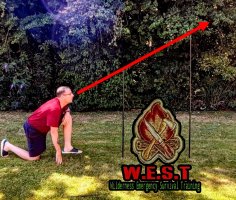So..what do we do to find a cardinal direction of travel at night if we can't see a recognisable constellation but there are stars visible? We can use the L.U.R.D method that only needs one star.
Place two different size sticks/ poles approx 1 metre apart...kneel/ squat down behind the smaller stick and line the top of it up with the top of the longer pole....viewing along that line to your chosen single star you now observe it for a shift which will occur after approx 15-20mins.
If the Star appears to move 'LEFT' then you will be facing NORTH.
If it moves 'UP'..EAST
If it moves 'RIGHT' ..SOUTH
and
If it moves 'DOWN'..WEST.
L-U-R-D
N-E-S-W
Nb...this method is not precise, especially in the Northern Sky and at the Poles, as with all other natural navigation methods they are only used to give a general direction..You should always use more than one type of Natural navigation method to dial in your direction of travel...and this really should be done during daylight hours.

Place two different size sticks/ poles approx 1 metre apart...kneel/ squat down behind the smaller stick and line the top of it up with the top of the longer pole....viewing along that line to your chosen single star you now observe it for a shift which will occur after approx 15-20mins.
If the Star appears to move 'LEFT' then you will be facing NORTH.
If it moves 'UP'..EAST
If it moves 'RIGHT' ..SOUTH
and
If it moves 'DOWN'..WEST.
L-U-R-D
N-E-S-W
Nb...this method is not precise, especially in the Northern Sky and at the Poles, as with all other natural navigation methods they are only used to give a general direction..You should always use more than one type of Natural navigation method to dial in your direction of travel...and this really should be done during daylight hours.

Last edited:

